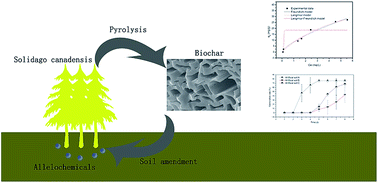Biochar preparation from Solidago canadensis and its alleviation of the inhibition of tomato seed germination by allelochemicals
Abstract
Solidago canadensis is a malignant invasive plant widely distributed in China. In this study, it was used as a biomass source to prepare biochar via an oxygen-limited pyrolysis method. The effect of temperature, heating rate and pyrolysis time on the yield and surface characteristics of the biochar was identified. The adsorption properties for dimethyl phthalate (DMP), a typical allelochemical of Solidago canadensis, of the biochar were explored. In addition, a pot experiment was conducted to reveal the effect of the biochar on tomato seed germination in the presence of allelochemicals. The maximum yield of the biochar was observed when Solidago canadensis was pyrolyzed at 300 °C for 2 h, with a heating rate of 8 °C min−1. Variation of pyrolysis conditions had little influence on the surface characteristics of the biochar. The adsorption of DMP on the biochar could be well described by the Langmuir model, with a maximum adsorption capacity of 59.37 mg kg−1. The addition of biochar to the soil could promote tomato seed germination in the presence of allelochemicals. Therefore, the biochar prepared from Solidago canadensis can be used for soil amendment for invaded sites.



 Please wait while we load your content...
Please wait while we load your content...